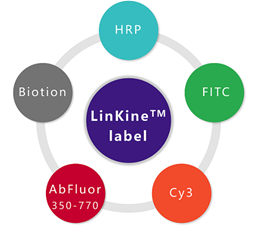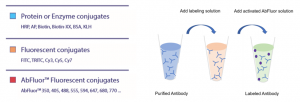Essential guidance|Protein ‘Linkine’ Knowledge Class has started, come to learn!
Application background of ‘linkine’ (protein/antibody labeling) technology
1.How to define coupling?
Enzymes, biotin, fluorescein, agarose, magnetic beads and other substances that are easy to detect or separate are covalently labeled or conjugated to antibodies, proteins or other small molecular substances using certain techniques.
2.Why is there a ‘linkine’ (protein/antibody labeling) technology?
The coupling of antibodies, proteins or other small molecules is a necessary step for many types of biological experiments. such as:
In order to detect specific proteins in immunoassays (such as WB/IHC/IF and other immunological experiments), we couple the primary or secondary antibody with enzymes, luciferin, etc.;
In cell staining (bioimaging) applications, the reactive dye (fluorescein) is directly combined with the protein (polypeptide) outside or inside the cell to produce visible and measurable staining;
Coupling proteins or antibodies to agarose or magnetic beads provides a method of targeted purification. For example, the agarose (magnetic beads)-conjugated antibody used by Abbkine for IP experiments directly eliminates the use of Protein A/G.
In order to simplify the coupling process, commercial kits and services came into being!
Linkine Labeling series product line

AbFlour series is a perfect alternative to Alexa Flour, Dylight.
1.What are the connotation and extension of LinKine™ labeling series product line?
- LinKine™ labeling kits provides a complete set of reagents for rapid labeling of antibodies, proteins, peptides and other biomolecules. Only 3 simple steps are required to obtain high-quality coupling products.
- They can directly label HRP,Biotin,FITC,Cy3,AbFluor ™ Fluorescent dyes meet the needs of scientific research applications, drug development and diagnostic kit development.
- Easy to operate, stable and efficient, coupled with labeled antibodies, compatible with various immunological applications, such as ELISA, flow cytometry, western blot, immunohistochemistry and immunofluorescence.

2.What biomolecules can be labeled?
Antibodies, proteins, peptides, biomolecules, etc. (including free amino groups), the primary amino group in the structure-NH2.
3.What types of conjugates are there?
- Enzyme/Biotin
| Product name | Product NO. |
| LinKine™ HRP Labeling Kit | KTL0100 |
| LinKine™ AP Labeling Kit | KTL0110 |
| LinKine™ Biotin Labeling Kit | KTL0120 |
| LinKine™ Biotin-XX Labeling Kit | KTL0125 |
- Traditional fluorescent dyes
| Product name | Product NO. |
| LinKine™ FITC Labeling Kit | KTL0210 |
| LinKine™ Cy3 Labeling Kit | KTL0220 |
- AbFlour A new generation of fluorescent dyes
| Product name | Product NO. |
| LinKine™ AbFluor™ 350 Labeling Kit | KTL0500 |
| LinKine™ AbFluor™ 405 Labeling Kit | KTL0510 |
| LinKine™ AbFluor™ 488 Labeling Kit | KTL0520 |
| LinKine™ AbFluor™ 555 Labeling Kit | KTL0530 |
| LinKine™ AbFluor™ 594 Labeling Kit | KTL0540 |
| LinKine™ AbFluor™ 647 Labeling Kit | KTL0550 |
| LinKine™ AbFluor™ 680 Labeling Kit | KTL0560 |
| LinKine™ AbFluor™ 750 Labeling Kit | KTL0570 |
Linkine Labeling series product
Provide form: kit
Main components: labeling solution (labeling solution); activated enzyme/dye (activated solution); termination powder/purification column
Specification: 3*20 μg/100 μg/3*100 μg/1 mg
Storage: The kit, HRP and biotin can be stored at 4 degrees for 6 months, and the fluorescent dye coupling kit can be stored at -20 degrees for 6 months.
Coupling product, short-term use, storage at 4 degrees for at least one month; long-term storage, aliquot stored at -20 degrees, or add an equal volume of glycerol, the fluorescent conjugate should be protected from light.
Frequently Asked Questions FAQ
Q1. How do customers choose specifications?
Our specifications are based on the most suitable labelable antibody amount, because different molar ratios can be coupled, but the coupling efficiency is different.
Such as 100 µg, labeling from 75 µg to 300 µg and optimized for 100 µg of antibody
Q2. Can customers label proteins according to the steps of our experimental system?
By default, our kit uses antibodies to explore the optimal ratio and experimental system steps. If the customer needs to label the protein, it needs to be adjusted according to the molecular weight of the protein. Of course, it must be labeled according to our system, but it may not be the most suitable. Condition.
Q3. How many times can the kit be done?
HRP requires stop solution, 1 tube for 1X specification, 3 tubes for 3X specification, because the powder must be used within 48 hours after dissolving, so 1X can be used for 1 time, 3X can be used for 3 times; other boxes need purification column, 1X There are 2 specifications and 3 3X specifications, so you can do 2 times for 1X and 3 times for 3X.
Q4. What are the requirements for the components of the antibody solution? Antibody concentration requirement?
PBS is generally recommended, not containing glycine and other amino-containing components, and the concentration of glycerol should not be too high. For details, please refer to the reagent preparation part of the instruction manual.
The antibody concentration is generally required to be greater than 2mg/ml, because the final concentration of the system is 2mg/ml, if the concentration is too low, it is recommended to concentrate in order to achieve the appropriate coupling efficiency.
Q5. What about coupling efficiency?
Each dye is different. Generally, it is appropriate to couple 3-6 fluorescent dyes to an antibody. Different antibodies may have some differences due to their different structures.
a: Antibody concentration calculation: C(mg/mL) = {[A280 -(Amax×Cf)]/1.4} × dilution factor.
- C refers to the concentration of the conjugate collected in the experiment;
- Dilution factor refers to the dilution factor in photometric measurement;
- A280 and Amax respectively refer to the absorbance at 280 nm and the absorbance at the maximum absorption wavelength;
- Cf is the correction factor, which is different for different dyes;
- 1.4 refers to the extinction coefficient of IgG (mL/mg).
b: DOL calculation: DOL = (Amax × Mwt × dilution factor)/(ε × C)
- Amax refers to the absorbance at the wavelength of maximum absorption;
- Dilution factor refers to the dilution factor in photometric measurement;
- C refers to the concentration of the conjugate collected in the experiment;
- Mwt refers to the molecular weight of the sample to be labeled;
- ε is the extinction coefficient of the dye.
- The biotin labeling kit can be detected by the HABA-avidin method.
- HRP labeling kit, labeling rate=OD403/OD280.
For the great love of "Yinfan", we will have great scientific research surprises waiting for everyone. At the same time, in order to provide a platform for readers to learn biological knowledge, Abbkine’s technical experts have worked tirelessly to sort out the dry goods of a variety of high-end biological experiments, and later published them in the WeChat public account. Please continue to pay attention to Abbkine for readers who love science the public.

![]()
Inspire your cell and protein
Abbkine focuses on the fields of proteinology and cytology, and is committed to the innovation and research and development of various antibodies, proteins, analytical reagents and kits, in order to become a key promoter in the development of life science research, drug development and other fields. We provide you with the favorite products of protein and immune research users, from basic immunological products, such as protein extraction and quantification, to internal reference label antibodies, primary antibodies and secondary antibodies for immunological experiments; the favorite products of cell research users, from Dyes and kits for detecting cell status, organelle extraction kits, cell substructure staining and tracking and cell metabolism detection products, to cytokine and protein detection kits for cell culture, just to help your research career !











